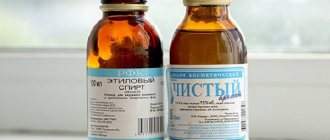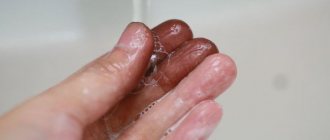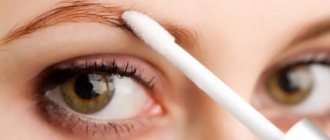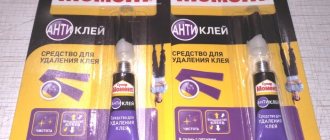Carrying out repairs, dyeing hair, doing arts and crafts and other work often lead to getting your hands dirty.
Removing paint can be very difficult. Chemical and mechanical methods come to the rescue.
Let's figure out how to remove stamp, construction, art, and hair dye from your hands.
How can I remove it?
There are three main ways to wash paint off your hands:
- Products with an abrasive effect, such as washing powder.
- Natural solvents (for example, citric acid).
- Chemical solvents (gasoline, acetone, etc.)
Removing the coloring agent by any of the methods, to a greater or lesser extent, negatively affects the skin of the hands, which then needs to be moisturized and nourished with the help of creams.
Gasoline and kerosene
Gasoline (preferably purified) and kerosene can act as effective solvents. They should be used carefully, avoiding smearing the substance on the skin of your hands that is not stained with paint.
Application:
Soak a rag in kerosene or gasoline.- Rub the stained areas on your hands for a minute.
- Rinse with water.
- Wash your hands with soap.
- Pat skin dry.
- Apply hand cream.
The advantage of the cleaning method is efficiency.
There are also disadvantages:
- toxicity of the substance itself and its fumes;
- irritating effect on the skin;
- not recommended for use in children.
Acetone
This substance belongs to the universal cleaners. It is used to remove contaminants.
Apply it directly to the areas of contamination and rub for a few seconds, then wash your hands with soap.
Acetone has an unpleasant, pungent odor, but it is good at removing polyurethane dyes and silicone sealant residues from hands and other surfaces. The advantages and disadvantages of acetone are the same as the previous method.
Oil products
In cases where the skin is stained with acrylic, enamel and nitro-enamel, oily, fatty substances can be used for cleaning.
For use you can choose:
- vegetable oils;
- melted butter;
- melted margarine;
- animal fat.
Advantages of this method:
- Environmentally friendly.
- Harmlessness.
- When rubbing a greasy product, you don’t have to be afraid that it will get on unstained skin - it won’t cause any harm.
- Can be used even by children.
There is only one drawback - poor efficiency . In order for the fat applied to the skin to remove the paint, you need to rub it in for 5 to 10 minutes.
The oil may not be effective against some stains, or when the skin on your hands is significantly dirty.
How to remove with washing powder?
The abrasive property of the powder is used to clean hands. The effect is achieved by purely mechanical action on the stains.
Procedure:
- Apply a small amount of powder to the area where your hands are dirty;
- rub;
- wash off.
The disadvantage of this method is its negative impact on the skin of the hands. The sharp edges of the grains during active friction not only destroy the paint layer, but also injure the skin.
Intensive cleaning may damage the skin - the formation of abrasions and wounds that will have to be further processed and treated.
Instead of washing powder, the following substances can be used: salt, soda and even sugar.
Toothpaste
The active substances in toothpaste can also serve as a means of removing paint from hands.
Mode of application:
- Wet your hands with water.
- Squeeze a small amount of toothpaste onto the stained hand.
- Use the fingers of your other hand to rub the paste into the stain.
It is not advisable to use pastes with a strong menthol effect for removal, as they can cause irritation.
Lemon acid
The use of natural acids is one way to remove paint from skin. Despite its natural origin and use, even in cooking, citric acid is quite caustic if applied directly to the skin.
For treatment, it is convenient to use a napkin or sponge (if the stain is very small) . After removing the dye using acid, you must wash your hands. You can also use acetic acid.
Alcohol
Preparations containing alcohol can serve as solvents if no other means are at hand.
Suitable for cleansing:
- vodka;
- medical alcohol;
- alcohol-based antiseptics, etc.
Application:
- Apply an alcohol-containing substance to the paint using a napkin.
- Process for about 10 minutes.
- If the alcohol has evaporated and the napkin has dried, it is moistened again.
- Wipe your hands with a rag.
- Wash your hands with soap.
- Apply hand cream.
Alcohol dries out the skin of your hands.
Solvents
Special preparations that are designed specifically for a specific type of paint are one of the best ways to clean your hands quickly. For this purpose , a solvent is selected, on the basis of which the coloring composition itself was made .
Upon contact with the paint, the chemical used is absorbed into it, destroying it, and transforming it into a liquid, easily removable state.
To apply the solvent to dirty hands, you can use, depending on the size of the stained area, a rag, sponge or cotton swab.
Procedure:
- Moisten a swab or rag generously in solvent.
- Carefully and gently wipe the stains on your hands. Excessive force should not be used so as not to further injure the skin.
- Rub for no more than 60 seconds. During this time, the paint, dissolving, will begin to transfer to the rag.
- If the used rags become significantly stained, a new rag is taken for processing. This is necessary so as not to stain your hands with paint again.
- After the hands are cleaned, they are washed using toilet soap to remove the chemical from the skin.
- Apply a rich cream to your hands.
It should be borne in mind that solvents are very aggressive chemicals, skin contact with which must be kept to a minimum.
Solvent
This is the best and most effective product , as it removes almost any paint. At the same time, it easily copes with both fresh and dried stains. To remove paint, it is recommended to use White Spirit solvent . Upon contact with a stain, the product is gently absorbed into its structure, returning the material back to its original liquid state . It may take 1 minute for the reaction to begin.
The solvent must be applied with a cotton pad, a soft, clean rag or regular cotton wool.
In addition to paint, it effectively dissolves silicone sealant and superglue.
At the time of use, the product dries and irritates the skin, even with short-term contact. Therefore, after removing the paint, it is necessary to thoroughly wash the treated areas with soap.
Removing paint using solvent
Features of removing various types of coloring agents
The best result of hand cleansing can be obtained if you know exactly what composition left the stains. Even inks such as stamp inks and those used in printers require a separate approach to removal.
Refill for printer and printing
If the printer toner is water-based, then fresh stains can be washed off the skin with regular running water . Be sure to wash your hands with cold water.
Otherwise, instead of washing, you can get the opposite result - fixing the color.
You can additionally use laundry soap, washing powder, or a brush to clean your hands.
Toner manufacturers provide for the dye to set when exposed to high temperatures, which is why you should not wash your hands in hot water.
The principle of operation of inkjet printer inks, which are made on an oil basis, is to impregnate layers of paper.
The same thing happens with the skin of your hands. When washing, it is possible to wash off only the top layer of dye .
The pigment will disappear completely only after a few days. One option for using home remedies is to use a recipe based on washing powder and citric acid. You can speed up the process by washing your hands frequently.
In addition to the methods listed, it is recommended to use products that are designed to remove printing and other types of inks.
- special cleaner Strong & Safe Flexographic ink Hand Cleaner;
- Fast Orange Pumice Bar Hand Soap;
- deep cleaning lotions, etc.
Construction and art
You can remove stains left by water-based paints from your hands by washing your hands with soap and water. If the pigment is difficult to remove, it is recommended to rub the skin with the hard side of a washcloth or brush.
For acrylic, nitro enamel and enamel, the role of solvent is played by:
- acetone,
- petrol,
- White Spirit.
Oil products can also be used. The water emulsion, if it has dried, can be washed off by washing your hands with washing powder and using a brush. Caustic washes and paint thinners should not be used to clean hands, as they can cause chemical burns.
For hair
You can remove hair dye from your hands by simply washing with water if the problem was noticed right away.
Over time, you will have to use either a professional remover or put into practice recipes based on oil products, citric acid, washing powder, etc.
Acetone
This product is quite often used in everyday life , as it is a universal cleaner for any contaminants. Paint is no exception. Acetone perfectly removes stains from hands without leaving any residue. However, it smells unpleasant, is toxic and flammable. Therefore, it is recommended to use it with cotton wool or cloth, adhering to safety precautions.
Removing paint from hands using acetone
How to remove traces of cement from hands and nails
Cement is a rather harmful substance for the skin. Those who have ever gotten dirty with it know that it causes dryness, itching and burning.
Sometimes cement masses can even corrode the skin. Therefore, removing this unsafe composition from your hands is a priority task after repair work. Fresh cement marks can be washed off with soap or another detergent. But after a while the mixture dries out and you have to look for another way out. Special store-bought detergents containing an abrasive substance can come to the rescue. After removing the cement, it is very important to take care of the skin, lubricate it with a nourishing cream or even healing ointments, such as “Rescuer” (if there are obvious damage to the skin).
Cleansing skin and nails from fuel oil
To remove traces of fuel oil from your hands, it is recommended to use the following methods:
- Getting rid of stains using chemicals (washing powder, special store-bought compositions for cleaning stubborn stains from leather, car shampoo or solvents, the safest of which is motor oil).
- Removing dark matter using folk remedies that do not have such an aggressive effect on the skin.
The first method of preparing a composition that can remove traces of fuel oil from clothes : you need to take a container, pour a handful of starch and soda into it, pour in ammonia and turpentine (0.5 tbsp each). Mix the ingredients to a paste , apply to the skin of your hands or clothes and wait until the substance dries. Wash off with warm water and soap. You just have to pay attention that this product can ruin dyed fabrics. Therefore, before using it, it is better to test it on a small piece from the reverse side. The second fairly effective substance for cleansing the skin of fuel oil is coffee grounds. You just need to rub your hands and other dirty areas well with it, and then wash it off along with the dirt.
Elderberries also have cleansing properties ; with their help you can easily get rid of fuel oil on the skin. To do this, you need to crush them and rub them thoroughly with your hands - the dirt will come off. Unripe red currants or gooseberries have approximately the same effect. Sorrel can be used for the same purposes.
Tips to make sure stains go away
When you know how to remove hair dye from skin, this is already half the success. All you have to do is arm yourself with useful tips so that the procedure goes without a hitch.
- Everything should be in moderation. Whatever product you choose, use it in moderation. Otherwise, you risk ruining your clothes. It's even worse if the substance gets into your eyes.
- Act quickly. Immediately after dyeing, carefully inspect the skin for contamination. If you identify paint stains in time, it will be much easier to deal with them.
- Prepare your skin. To make it easier to remove hair dye from your scalp, face or body, be sure to steam it.
- Use professional products. If you often dye your hair, it makes sense to purchase a remover that will quickly and, judging by the reviews, remove stains without harming the skin. Choose the same brand of paint and remover.
- Listen to your skin. Before wiping hair dye off your skin, do an allergy test by applying a small amount of the product to the crook of your elbow. Carry out the procedure if you do not feel any discomfort within ten minutes.
- “Wedge with wedge...” Apply the mixture remaining after dyeing to the stained area of skin and rub a little. Rinse quickly with water so that the new portion of paint does not have time to be absorbed.
It is always easier to prevent a problem than to solve it. Therefore, before you start dyeing your hair, take care to protect your skin from pollution. To avoid getting your hands dirty, wear gloves. Drape a towel or old T-shirt over your shoulders. Lubricate your face along the hairline, as well as your ears, with a thick cream so that the paint does not absorb into the skin.
Beauty is a fragile category. Even if you have refined facial features, luxurious hair and a chiseled figure, the slightest flaw can ruin the impression of your image. If you regularly dye your hair, you need to arm yourself with the knowledge of how to remove hair dye from your skin. Use the right tools and the problem will be solved as soon as possible.
Removing oil paint marks
If your hands are slightly dirty, butter or vegetable oil can help solve this problem.
You need to take a small amount onto a cloth and rub the stains with it until they dissolve. This may take some time, but it will not harm the skin. Among chemical products, nail polish remover can help. The same white spirit or acetone. These liquids are usually used if the area of contamination is large. But they can dry out the skin a lot, so after cleansing you need to use a cream.
| If dye gets on your hair, it is better to remove it with oils. |
If paint gets under your nails
How to remove traces of hair dye from skin? There are many options. But what to do if the coloring composition has become embedded in the nails or has gotten under the nail plate? You can paint it with bright varnish to hide the embarrassment, but it is better to remove the paint completely using available means.
- Acetone. Rub your nails with nail polish remover. To clean the subungual space, use a toothpick with a little cotton wool soaked in acetone wrapped around the tip.
- Potato. Peel and wash the raw potatoes, cut in half. Scrape along the cut to get the starch as deep as possible under the nails. You can also rub the slice on your nail plate to polish it.
- Wash. At home, the easiest way to remove dirt under your nails is by hand washing. Laundry soap or washing powder are excellent tools in the fight against hair dye.
- Vinegar. Soak a sponge or cotton swab in the product and rub your nails with force. You can dip your fingers in the bath for a quarter of an hour. To prepare it, mix vinegar (9%) with three parts water.
Video on the topic
Methods for removing natural dye
Henna is persistent, so getting rid of it is quite difficult. To get the maximum effect, you can use folk remedies - hydrogen peroxide, scrub, lotion, nail polish remover. More radical methods will also help to cope with the problem:
- Dissolve a small amount of liquid soap in hot water and place your hands in the bath. Rub the well-steamed skin with an old toothbrush or pumice stone;
- combine baking soda and lemon juice, apply the resulting slurry to contaminated areas and rub in with light massage movements;
- Grind sea salt in a coffee grinder and apply to moistened, contaminated areas.
Before using aggressive products on a large scale, it is worth checking the skin's reaction in a small area.
Do not use pure lemon juice or vinegar to cleanse your skin. These remedies, used separately, will consolidate the result and only aggravate the problem.
How to remove paint from clothes from a bench?
White spirit is suitable for removing stains from dyes on clothes. The specified gasoline solvent is the best way to remove paint from clothes from a bench. It is necessary to moisten a cotton pad in white spirit. Rub the stain in a circular motion.
Interesting materials:
How to save electricity? How to reset Huawei MediaPad t3? How to reset a ps4 controller? How to reset a tablet to factory settings? How to reset the latest updates via BIOS? How to remove sealant from a bathtub? How is sick maternity leave calculated? How is the total area of a private house calculated? How is pension calculated in 2022? How to calculate dividends on shares?
Preventing contamination
So that you don’t have to look for a method of cleansing your skin from hair dye, use these simple tips:
- when using dyes, wear latex gloves on your hands;
- Carry out the coloring procedure at least 24 hours after the last hair wash - natural sebum will protect the skin from pigment;
- Apply a rich moisturizer along the hairline;
- Cover your neck, décolleté and body with cotton cloth;
- remove dye from the skin as soon as you notice it.
To avoid having to look for a way to remove paint from your skin, entrust the dyeing process to professionals
You can wash the skin of your face and hands from hair dye yourself at home, using folk remedies or professional preparations. Do not delay the process, but get down to business right away to avoid pigment fixation in the dermis.
Oil
To remove paint, it is best to use olive or sunflower oil . They erase dried acrylic paint, enamel and nitro paints well. In some cases, warm melted margarine
To remove paint from your hands, you need to apply the oil to a cotton swab or cloth, then wipe thoroughly . This product does not contain chemicals and is therefore safe for the skin. It will take about 5-10 minutes to completely dissolve the paint. Cleaning time depends on the degree of contamination.
Harm caused by paint: effect on the body
Substances in paints can have a negative effect on the human body in three areas: breathing, skin, and digestion.
Entry through the respiratory tract is considered the most dangerous, since the absorption of toxic substances into the blood in this case occurs much faster. Solvents in paints also have a negative effect. A small dose of their concentration causes excitement, and a high dose causes headaches, dizziness, increased irritability, drowsiness, nausea and vomiting. Therefore, the room in which paint and varnish work is carried out must be ventilated.
Dyes can enter the digestive tract Therefore, personal hygiene should not be neglected.
Contact of paint on the skin is no less harmful. The body's response in this case may be the appearance of inflammation or allergies, so you should begin removing the stain immediately. Below is how to do this most effectively and harmlessly.
Reviews
To have an idea of the effectiveness of a professional or folk remedy, it is worth studying real reviews about their use.
A little about removers
Marina, 26 years old
Estel Skin Color Remover is what I have been looking for for a long time. For me, the product is perfect: safe and fast, instantly removes blemishes from the skin. One bottle lasts a long time, I use a little at a time.
Olga, 49 years old
I use Igor Remover from Schwarzkopf. This lotion can erase even the most difficult stains, including those on the hands and neck. Everything happens very quickly, after one simple processing. I always keep it at hand and quickly remove all drops of paint before washing off my hair.










